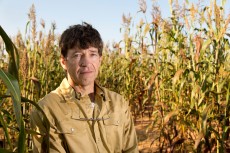Canola genome sequence reveals evolutionary ‘love triangle’

UGA Regents Professor Andrew Paterson heads the university's Plant Genome Mapping Laboratory.
Canola is grown across much of Canada and its native Europe, but the winter crop is increasingly cultivated in Georgia. Canola oil used for cooking is prized for its naturally low levels of saturated fat and rich supply of omega-3 fatty acids, but the plant is also used to produce feed for farm animals and as an efficient source for biodiesel.
“This genome sequence opens new doors to accelerating the improvement of canola,” said Andrew Paterson, Regents Professor, director of UGA's Plant Genome Mapping Laboratory and co-corresponding author for the study. “We can use this knowledge to tailor the plant's flowering time, make it more resistant to disease and improve a myriad of other traits that will make it more profitable for production in Georgia and across the country.”
Canola has one of the most complex genomes among flowering plants, forming thousands of years ago during the Neolithic Era when two plant species-Brassica rapa and Brassica oleracea-combined in the wild. Plants in the B. rapa family include turnips and cabbages, while B. oleracea encompasses cauliflower, cabbage, collards, broccoli, kale and other common vegetables.
The Plant Genome Mapping Laboratory played prominent roles in the sequencing both B. rapa and B. oleracea in 2011 and 2014, respectively.
“Understanding the genomes of B. rapa and B. oleracea was key to piecing together the canola genome,” Paterson said. “It's like a genetic love triangle between the three species, with canola sometimes favoring genes from B. rapa or B. oleracea or sometimes both.”
While much the world's canola is used to make cooking oil and protein-rich animal feed, it is also used in the production of lipstick, lip gloss, soap, lotion, printing ink and de-icing agents.
The growing interest in carbon reduction and more environmentally friendly fuel alternatives is also good news for canola growers, as this genome sequence may ultimately help researchers develop feedstocks that are suited to more sustainable biofuel production.
Global canola production has grown rapidly over the past 40 years, rising from the sixth largest oil crop to the second largest, according to the U.S. Department of Agriculture.
Much of the production in America is concentrated along the northern plains, but the recent construction of a canola processing plant near the South Carolina-Georgia border has spurred interest for growers in the Southeast.
Additional UGA researchers for the project include Xiyin Wang, assistant research scientist and co-first author for the paper; Tae-ho Lee and Yupeng Wang, former postdoctoral researchers; and current and former graduate students Hui Guo, Huizhe Jin, Jingping Li, Xu Tan, Haibao Tang, and Yupeng Wang.
Media Contact
More Information:
http://news.uga.edu/releases/article/canola-genome-sequence/All latest news from the category: Life Sciences and Chemistry
Articles and reports from the Life Sciences and chemistry area deal with applied and basic research into modern biology, chemistry and human medicine.
Valuable information can be found on a range of life sciences fields including bacteriology, biochemistry, bionics, bioinformatics, biophysics, biotechnology, genetics, geobotany, human biology, marine biology, microbiology, molecular biology, cellular biology, zoology, bioinorganic chemistry, microchemistry and environmental chemistry.
Newest articles

A universal framework for spatial biology
SpatialData is a freely accessible tool to unify and integrate data from different omics technologies accounting for spatial information, which can provide holistic insights into health and disease. Biological processes…

How complex biological processes arise
A $20 million grant from the U.S. National Science Foundation (NSF) will support the establishment and operation of the National Synthesis Center for Emergence in the Molecular and Cellular Sciences (NCEMS) at…

Airborne single-photon lidar system achieves high-resolution 3D imaging
Compact, low-power system opens doors for photon-efficient drone and satellite-based environmental monitoring and mapping. Researchers have developed a compact and lightweight single-photon airborne lidar system that can acquire high-resolution 3D…





















